|
Displaying items by tag: Parrish Art Museum
The Parrish Art Museum will debut an extensive survey of the photography of Chuck Close, one of the most important figures in contemporary art, opening this Sunday, May 10 with a reception at 11 a.m.
On view through July 26, the exhibition will feature some 90 images from 1964 to the present, showcasing an arc of the artist’s exploration of photography— from early black and white maquettes to monumental composite Polaroids and intimately scaled daguerreotypes and his most recent Polaroid nudes. The exhibition explores how Mr. Close has stretched the boundaries of photographic means, methods and approaches.
Once derided as a slavish admirer of Renoir, the painter and illustrator William Glackens is among the most intriguing and underestimated participants in the first wave of 20th-century American modernism. That perception is confirmed by the enlightening and overdue, if still deficient, survey of his dappled canvases and dazzling drawings at the Parrish Art Museum here. It should be required viewing for anyone interested in the period.
Glackens, who was born in Philadelphia in 1870 and educated at that city’s prestigious Central High School, was briefly affiliated with a loose group of urban-conscious realist painters known first as the Eight and later as the Ashcan School.
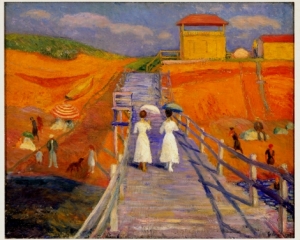
From July 20 through October 13, the Parrish Art Museum presents William Glackens—the first comprehensive survey of the artist’s work since 1966. The exhibition spans Glackens’s career from the 1890s through the 1930s, with more than 70 important paintings and works on paper from some of America's finest private and public collections, including the Metropolitan Museum of Art, Fine Arts Museum of San Francisco, the National Gallery of Art, and the Cleveland Museum, among others. Several works in the exhibition are on view to the public for the first time since 1966.
William Glackens, co-organized and presented by the Parrish Art Museum; Nova Southeastern University Museum of Art | Fort Lauderdale (where it was on view earlier this year); and the Barnes Foundation, Philadelphia (where the exhibition will also travel), spans the full career of the artist, who painted on Long Island from 1911–1915. Curated by writer and art historian Avis Berman, the exhibition focuses on Glackens’s most distinctive and adventurous works.
On Saturday, July, 12, the Parrish Art Museum welcomed over 1,000 guests, including artists, business leaders, and philanthropists, to its Herzog & de Meuron-designed building in Water Mill, New York. The museum’s annual fundraising soiree, which was hosted by museum director Terrie Sultan, raised an unprecedented $1.25 million for the institution.
The Parrish’s light and airy home, which opened in 2012, was styled by the New York City-based studio Ron Wendt Design. The decor was inspired by Jennifer Bartlett’s painting, “Amagansett Diptych #1,” a richly-hued beach scene made up of delicately woven, grid-like brushstrokes.
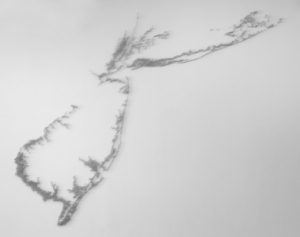
In the third iteration of its Platform series, the Parrish Art Museum presents artist Maya Lin, whose ecologically inspired works exist at the intersection of art, architecture, and environmental science. Platform: Maya Lin, opening July 4 and continuing through October 13, 2014, reveals the artist's exploration of how humans experience and impact the landscape. It will be on view during the Parrish Art Museum's annual gala, the Midsummer Party, on July 12, 2014.
Platform: Maya Lin features Lin's Pin River-Sandy (2013), a massive geographical installation depicting the boundaries of Hurricane Sandy's flood plain, composed of thousands of straight pins. Installed on the east wall of the Norman and Liliane Peck/Peter Jay Sharp Foundation Gallery, the work has a span of 12 feet (112 5/8 x 144 x 1 1?2 inches). Lin's three marble sculptures, Arctic Circle (2013), Latitude New York City (2013), and Equator (2014), representing the typographies at each of these positions on the globe, are installed in concentric rings in the center of the gallery floor. Three new, recycled silver works, Accabonac Harbor (Long Island Triptych), 2014, Georgica Pond (Long Island Triptych), 2014, and Mecox Bay (Long Island Triptych), 2014, are particularly relevant to the location of the Museum on Long Island's East End, and are installed on the wall opposite Pin River-Sandy.
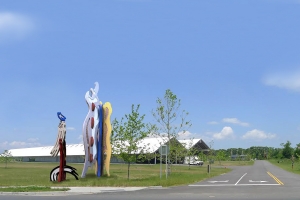
On Friday, April 18, the Parrish Art Museum in Water Mill, New York, will receive Roy Lichtenstein’s towering sculpture, “Tokyo Brushstroke I & II.” The work, which is being loaned to the museum by the Roy Lichtenstein Foundation, courtesy of Glenn and Amanda Fuhrman and the Fuhrman Family Foundation, will be placed on the Parrish’s front lawn, near the Montauk Highway. It will be the first long-term outdoor installation at the museum’s new Herzog & de Meuron-designed building, which opened in November 2012.
The two-part sculpture, which stands 33 feet tall at its highest point and weighs around 17,000 pounds, will be installed with a crane into a cement brace and joined together on site. The work is from Lichtenstein’s “brushstroke” sculpture series from the 1990s. Similar works can be found in Madrid, Paris, Singapore, and Washington, D.C.
Lichtenstein, a pioneer of the Pop art movement, relocated to Southampton (less than five miles from the Parrish’s current campus) in 1970 and began an enduring relationship with the museum.
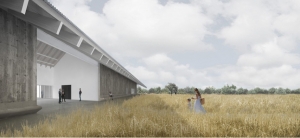
The Parrish Art Museum in Water Mill, NY is holding an anniversary weekend celebration from Saturday, November 9 through Monday, November 11. A full schedule of events including gallery talks, live music, and “meet the artist” events will ring in the Parrish’s one-year anniversary of its expansive, Herzog and DeMeuron-designed space.
During the celebratory weekend the Parrish will unveil seven new galleries in its 12,200-square-foot structure, which will house the museum’s permanent collection. The institution’s holdings include over 2,600 works ranging from the early 19th century through the 21st century. Childe Hassam, John Sloan, James McNeill Whistler, Dan Flavin and Chuck Close are all represented in the museum’s collection. The Parrish also boasts extensive holdings of works by William Merritt Chase and Fairfield Porter.
A biennial juried exhibition titled Artists Choose Artist will also take place. The event will showcase the artists of Long Island’s East End and the relationships that have helped create a strong artistic community there.
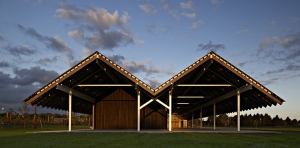
Earlier this month the Parrish Art Museum opened its new 34,400 square-foot building in Water Mill, NY to the public. Founded in 1898 by New York lawyer, Samuel Longstreth Parrish, to house his growing art collection, the museum had been a staple in Southampton, NY before moving to its new location that boasts seven sky-lit galleries and three times the exhibition space than that of the museum’s former home.
Now that the $26.2 million move is complete, the result of years of painstaking fund-raising, the Parrish hopes to become the area’s artistic epicenter. Designed by the Swiss architectural firm Herzog & Meuron in collaboration with the landscape architecture firm Reed Hilderbrand, the new Parrish building sits on 14 acres of land right off of the Montauk Highway. The building is meant to blend into the landscape and consists of connected, stretching barn-like structures that sit under a white corrugated metal roof. Large sections of glass allow the line between the natural and artificial worlds to blend.
An American art museum with about 2,600 paintings, sculptures, and works on paper in its collection, the Parrish pays extra attention to the art of the East End of Long Island. The former Southampton location was simply too small to exhibit many of the exemplary works from the museum’s permanent collection that spans from the 19th century to the present. Now, American Impressionist William Merritt Chase and the realist Fairfield Porter each have their own permanent galleries and there are three galleries just for temporary exhibitions.
Inaugurating the space is Malcolm Morley: Painting, Paper, Process, an exhibition devoted to the English-born artist known for exploring paper’s many artistic possibilities including watercolors, scale models, and freestanding sculptures. Approximately 50 works from the 1980s to present will be on view through January 13, 2013.
The Parrish’s new building also includes offices, a café, an expanded lobby, and a theater where film screenings, lectures, and performances will be held.
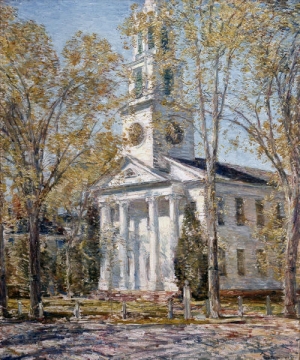
From July 1 through September 18, the Florence Griswold Museum in Old Lyme hosts an exhibition of over 40 American landscape paintings from the Parrish Art Museum in Southampton, New York. American Landscapes: Treasures from the Parrish Art Museum traces the evolution of American art from its roots in an emerging national landscape tradition to the liberating influences of European modernism. Some of the artists represented include William Merritt Chase, William Stanley Haseltine, Theodore Robinson, John Henry Twachtman, John Marin, John Sloan, Ernest Lawson, Fairfield Porter, and Alex Katz.
Of special interest is Lyme Art Colony painter Childe Hassam, whose view of the Church at Old Lyme (1906) will be featured. “We are delighted at the opportunity to present one of Hassam’s legendary paintings of the Congregational church, which put Old Lyme on the map artistically when he exhibited them here and in New York during the early years of the colony,” said Curator Amy Kurtz Lansing. “Partnering with the Parrish has allowed us to exhibit one of the treasures of American Impressionism.”
At the beginning of the nineteenth-century, artists of the Hudson River School were among the first to record the “New Eden” that was the North American continent. Their framing of the view into the distance, often with a solitary figure in the foreground, literally invented a new way of seeing. By the middle of the century, the border of the wilderness had been pushed farther west and industrialization had begun to transform the topography of the eastern United States. A painting like Samuel Colman’s Farmyard, East Hampton (ca. 1880) evokes a nostalgia for the vanishing rural scene.
|
|
|
|
|